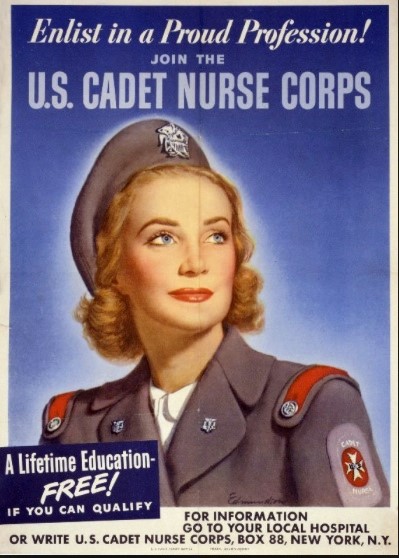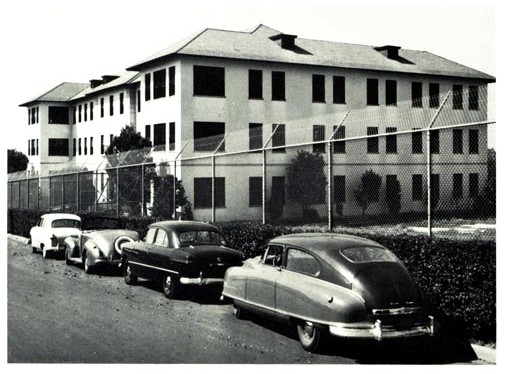© Constance J. Moore
Colonel, ANC (Retired), ANCA Historian
Ruth (Christ) Sullivan is definitely a sterling example of the greatest generation. She served her country during WWII as an Army Nurse, assigned duty at Brooke Army Station Hospital. How did she get there from the rural, cotton country of Lake Charles, LA?
Sullivan was the oldest of seven siblings who wanted to do something “different” with her life. Sometimes she dreamed of being a pilot, but common sense told her to apply to the nursing diploma program at New Orleans Charity Hospital after graduating from high school. The Sisters of Charity who ran the school told her that she was too young to enter the program at 17 years, but the following year, when she turned 18 years she could apply. All that changed when the Japanese bombed on 7 December 1941, the United States recognized that there would be a tremendous shortage of nurses as so many became needed in military facilities. The government strongly encouraged nursing schools to educate as many students as possible.
Suddenly, Sullivan’s age was no longer a discriminator. An administrator at Charity Hospital Nursing contacted Sullivan and asked her to come back to New Orleans for a new nursing class beginning 2 January 1942. Somehow she and her parents were able to quickly scrape up enough money to send her. Ruth loved the training at the state’s largest teaching hospital. She also liked the convenience of living and learning in the same building situated at the rear of the hospital. It was used as a dormitory, dining facility, assembly hall and classroom for the student nurses.1
 During the initial part of her schooling, Sullivan made an important decision to join the Cadet Nurse Corps to help defray the cost of her education. Charity Hospital Nursing School, in compliance with Cadet Nurse Corps guidelines, accelerated their program to graduate nurses faster. This meant that the training was compressed, with less time off, and longer hours in the clinical areas and the classroom.
During the initial part of her schooling, Sullivan made an important decision to join the Cadet Nurse Corps to help defray the cost of her education. Charity Hospital Nursing School, in compliance with Cadet Nurse Corps guidelines, accelerated their program to graduate nurses faster. This meant that the training was compressed, with less time off, and longer hours in the clinical areas and the classroom.
Sullivan loved being a cadet and was proud of the fact she in one of the first classes of cadets in the nation. She also liked the fact that her parents could stop paying her tuition and that she was given free uniforms and a monthly remuneration. Her stipend ranged from $15 a month for the first 9 months as a pre-Cadet, $30 a month for the next 21 months as a Junior Cadet, and from $30 to $60 a month during the last 6 months as a Senior Cadet.
 Brooke Army General Hospital during WWII Brooke Army General Hospital during WWII
|
As a Senior Cadet, Sullivan was required to fulfill a period of service in either a federal or civilian hospital in which they worked full-time. Sullivan elected to serve in an Army facility and was selected to work at Brooke Army General Hospital in San Antonio. Because the hospital was designated as a center for thoracic surgery in the Army system, it is not surprising that Sullivan was sent to work on a busy unit handling chest casualties from overseas. The nursing staff was constantly challenged to meet the needs of patients who arrived in groups after they were flown to the United States.
She met several former Japanese prisoners of war who were receiving medical care. One was General Wainwright, the commander of Allied Forces in the Philippines at the time of their surrender to the Empire of Japan. Another was an Army nurse who had been a captive. Sullivan “very much admired her because she had seen what war was all about.”2
After completing her clinical time at the military hospital, Sullivan returned to the Charity Hospital School of Nursing and graduated with her class. She decided to enter the Army and was sent to basic training. As her drill and ceremony skills were excellent, she was appointed a platoon leader during the schooling.
Sullivan was next assigned to McCloskey General Hospital in Temple, TX. It was one of the army's largest general hospitals used as a center for orthopedic, amputations, and neurosurgery. It provided expert care and treatment for all military personnel and had many specialists on its staff. “Its 3500 beds and 160 buildings were conveniently situated on 215 beautifully landscaped acres.”3 Sullivan recalled, “We worked 7:00 am to 7:00pm, or visa versa, with one day off. We took care of servicemen who had been injured at the front.”4
Ruth Sullivan is one of the generation who were involved in the tumultuous World War II journey through adversity and achievement, despair and triumph. And like others, she did not seek fame or recognition, but did it because the work needed to be done.
________________
1 Report of Charity Hospital of Louisiana at New Orleans 1 July 1946 to 30 June 1947. (n.p.), p.43.
2 Sullivan, R. Personal Communication, August 22, 2014.
3 Fath, S. &B. Hiller. (2010). The Greatest Generation as Reported in the Weekly Bastrop Advertiser during World War II. XLibris, Corp. p. 327.
4 Sullivan, R. Personal Communication, August 22, 2014.